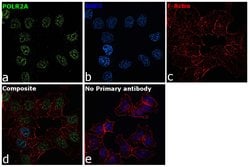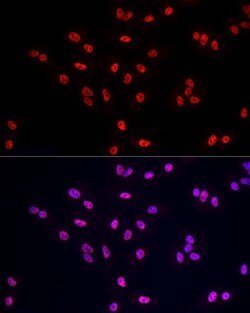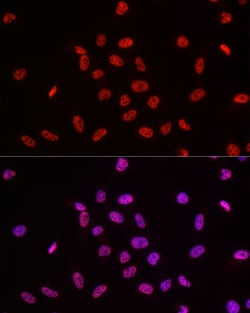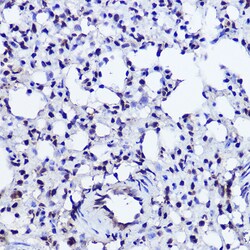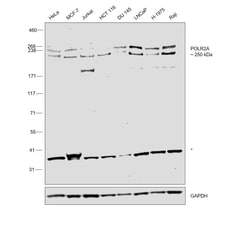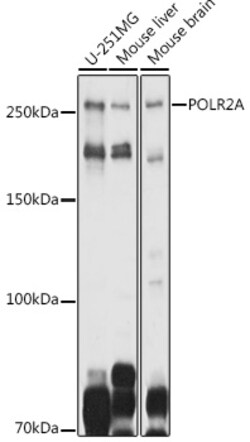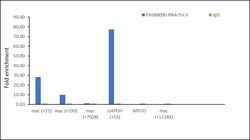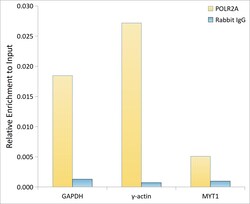Learn More
Invitrogen™ POLR2A Polyclonal Antibody
Rabbit Polyclonal Antibody
Supplier: Invitrogen™ PA588090
Description
Positive Samples: HeLa, BT-474, H460, Jurkat, Mouse testis, Mouse brain; Cellular Location: Nucleus Immunogen sequence: MHGGGPPSGD SACPLRTIKR VQFGVLSPDE LKRMSVTEGG IKYPETTEGG RPKLGGLMDP RQGVIERTGR CQTCAGNMTE CPGHFGHIEL AKPVFHVGFL VKTMKVLRCV CFFCSKLLVD SNNPKIKDIL AKSKGQPKKR LTHVYDLCKG KNICEGGEEM DNKFGVEQPE GDEDLTKEKG HGGCGRYQPR IRRSGLELYA EWKHVNEDSQ EKKILLSPER VHEIFKRISD EECFVLGMEP RYARPEWMIV TVLPVPPLSV.
DNA-directed RNA polymerase II subunit RPB1 (POLR1A) is a DNA-dependent RNA polymerase that catalyzes the transcription of DNA into RNA using the four ribonucleoside triphosphates as substrates. POLR1A is the largest subunit and is a catalytic component of RNA polymerase II which synthesizes mRNA precurors and many functional non-coding RNAs. It also forms the polymerase active center together with the second largest subunit. Pol II is the central component of the basal RNA polymerase II transcription machinery. It is composed of mobile elements that move relative to each other. RPB1 is part of the core element with the central large cleft, the clamp element that moves to open and close the cleft, and the jaws that are though to grab the incoming DNA template. At the start of transcription, a single-stranded DNA template strand of the promoter is positioned within the central active site cleft of Pol II. A bridging helix emanates from RPB1 and crosses the cleft near the catalytic stie and is through to promote translocation of Pol II by acting as a ratchet that moves the RNA-DNA hybrid through the active site by switching from straight to bent conformations at each step of nucleotide addition. During transcription elongation, Pol II moves on the template as the transcript elongates. Elongation is influenced by the phosphorylation status of the C-terminal domain (CTD) of Pol II's largest subunit (RPB1), which serves as a platform for assembly of factors that regulate transcription initiation, elongation, termination, and mRNA processing. Regulation of gene expression levels depends on the balance between methylation and acetylation levelts of the CTD-lysines.
Specifications
| POLR2A | |
| Polyclonal | |
| Unconjugated | |
| POLR2A | |
| 220kDa; DNA polymerase epsilon catalytic subunit; DNA polymerase epsilon catalytic subunit A; DNA polymerase II subunit A; DNA-directeced RNA polymerase II polypeptide A; DNA-directed RNA polymerase II largest subunit, RNA polymerase II 220 kd subunit; DNA-directed RNA polymerase II subunit A; DNA-directed RNA polymerase II subunit RPB1; DNA-directed RNA polymerase III largest subunit; DUN2; EC 2.7.7.6; hRPB220; hsRPB1; MGC75453; N0825; Pol II S2p; POL2; POLR2; Polr2a; POLRA; Polymerase (RNA II (DNA directed), large polypeptide; polymerase (RNA) II (DNA directed) polypeptide A; polymerase (RNA) II (DNA directed) polypeptide A (220kD); polymerase (RNA) II (DNA directed) polypeptide A, 220kDa; polymerase (RNA) II subunit A; POLYMERASE II; RNA; RNA POL2; RNA polymerase II 1; RNA polymerase II subunit A; RNA polymerase II subunit B1; RNA-directed RNA polymerase II subunit RPB1; RP02; RPB1; RPB220; RPBh1; Rpii215; RpIILS; RPO2; RPO21; Rpo2-1; RPOL2; SUA8; YNL262W | |
| Rabbit | |
| Affinity Chromatography | |
| RUO | |
| 20020, 363633, 5430 | |
| -20°C, Avoid Freeze/Thaw Cycles | |
| Liquid |
| ChIP Assay, ELISA, Immunohistochemistry (Paraffin), Western Blot, Immunocytochemistry | |
| 0.69 mg/mL | |
| PBS with 50% glycerol and 0.02% sodium azide; pH 7.3 | |
| P08775, P24928 | |
| POLR2A | |
| A synthetic peptide corresponding to a sequence within amino acids 1-260 of human POLR2A (NP_0009281). | |
| 100 μL | |
| Primary | |
| Human, Mouse, Rat | |
| Antibody | |
| IgG |
Your input is important to us. Please complete this form to provide feedback related to the content on this product.
